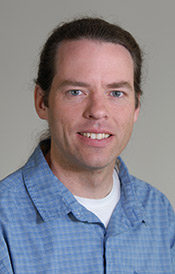I am UAA: Travis Rector, Ph.D., Professor of Astronomy and Physics
by Kathleen McCoy |
 Travis Rector, Ph.D.
Travis Rector, Ph.D.
Professor of Astronomy and Physics
If there is a shining star at UAA, it's professor Travis Rector. It's not just because he teaches astronomy but because he's a man of many titles with multiple accomplishments. He was one of the astronomers in the International Astronomical Union that voted to demote Pluto from planet to dwarf planet. He has also had many of his deep sky images featured in The New York Times, Newsweek, National Geographic and Time Magazine. Rector also uses telescopes in Arizona, New Mexico, Hawai'i and Chile for his research.
But Rector is not what you'd expect when you think of a science professor. He's an athlete who competes in many local ski, running and bike races. He is recognizable for his ponytail, which he jokes he can't cut. "A lot of people ask me about it, but I tell them I can't cut it because my grandmother likes it."
Travis grew up in Boulder, Colorado unsure of what path he wanted to take, much like some of the students he teaches today. "Growing up I was good at math and science and loved art. After I discovering I was really bad at art, I decided to be a scientist, and studying astronomy seemed the most interesting," Travis said.
Travis earned his B.S. in physics from Trinity University in San Antonio, where he met his wife Paola Banchero, who is the department chair of journalism and public communications at UAA. "She was dating a friend of mine when we met," he laughs, "but we didn't start dating until about eight years later."
After college, Travis moved back to Boulder to attend the University of Colorado where he earned his doctorate in astrophysics. "It definitely wasn't easy, but if you're interested in something it makes learning about it more fun," he said.
Travis and Paola moved to Alaska in 2003 to work at UAA. Since then, both have had a significant impact on the University and its students. For example, Travis took the lead in designing and building UAA's planetarium. "That's one of the accomplishments I'm most proud of. It took many years to make it happen--to get the funding, design, etc. It's such a great teaching tool now and now there's a cool factor that's been added to the University."
Travis said, "The planetarium is tremendously popular and encourages the Anchorage community to come out and see the campus and the new ConocoPhillips Integrated Science Building." Travis, along with Dr. Andy Puckett and Michelle Krok, host shows open to the public about astronomy and much more. "We're trying to branch out and use the planetarium for other topics as well, like biology."
Not only is Travis actively involved with the planetarium, but he's also an avid researcher at UAA and beyond. In 1995 he began a long-term project researching exploding stars called "novae" in the nearby Andromeda galaxy. He and his students take images of the galaxy about once a month to search for these stars as they explode. "When they explode, novae blow out heavy elements like carbon, nitrogen and oxygen. Stars and planets later form out these materials, possibly creating new planets that might be suitable for life. Our goal is to find out how often novae explode in the galaxy and learn more about the likelihood of Earth-like planets."
If you've never met or taken a course from Travis, you haven't experienced his enthusiasm for science and his ability to teach. Instead of the standard 75-minute lecture, he takes a different approach to teaching. "If a student listens passively for 75 minutes, research has shown that most of what is said gets lost; they really only retain about 10 or 15 minutes of the lecture," he said. So Travis uses concept tests during class, where he asks a multiple-choice questions and students hold up a sheet of paper with their answer. "It's a less confrontational way for students to learn and eases the pressure. If there is a mixture of answers in the room, it also gives students a chance to talk and learn from each other. It's a form of peer learning."
His passion for teaching and learning makes Travis an interesting person to know. His love of science is contagious and exciting. He is one of the bright lights at UAA and makes it a better campus for students, faculty, staff and the community.
Learn more about Travis and his deep sky images on his website.
 "I am UAA: Travis Rector, Ph.D., Professor of Astronomy and Physics" is licensed under a Creative Commons Attribution-NonCommercial 4.0 International License.
"I am UAA: Travis Rector, Ph.D., Professor of Astronomy and Physics" is licensed under a Creative Commons Attribution-NonCommercial 4.0 International License.









